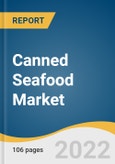The global canned seafood market size is expected to reach USD 50.47 billion by 2030, expanding at a CAGR of 5.9%. Increasing demand for essential fatty acids and proteins in consumer diets has contributed to the growth of canned seafood in the recent years. Moreover, the growing popularity of chemical-free packaged seafood with higher shelf life has promoted the adoption of canned seafood among consumers.
Technological advancements in tuna fishing coupled with Fish Aggregating devices and advanced packaging technology for fish products are anticipated to drive the industry growth during the forecast period. In addition, improved packaging procedures with the use of RFID tags to improve product traceability and agglomeration are expected to increase product adoption by the consumers, thereby contributing to the market growth. For instance, in March 2021, Thai Union Frozen products SPACE-F announced FoodsTech Accelerator and Incubator Program that allow food processing at a faster pace and preserve the quality of its food.
Canned Tuna held the largest segment in 2021 and is expected to maintain dominance during the forecast period. Canned tuna is broadly utilized in different day-to-day dishes and delicacies, including salads, croquettes, sandwiches, burgers, pasta, tacos, and sushi. Moreover, an increase in the availability of certified and sustainable canned tuna in the market has favored the growth of the market. For instance, in January 2020, Wild Planet Foods released the newest product line of flavored wild albacore tuna pouches. The company announced this new line in the following varieties: Jalapeño & Cumin; Lime & Basil; Sweet Chili Pepper; and Lemon & Thyme. These Albacore Wild Tuna pouches are 100% sustainably caught using pole & line fishing methods.
The retail segment contributed a majority of the share to become a larger division in the global revenue in 2021. Many offline stores, including convenience stores and supermarkets, have freezing and temperature-controlled facilities, which is driving the growth of retail distribution channels. Additionally, increasing penetration of independent retail giants is boosting product visibility and attracting a larger consumer base. Moreover, the rise in online purchases of canned seafood through online distribution channels is favoring the growth of the retail segment.
This product will be delivered within 1-3 business days.
Technological advancements in tuna fishing coupled with Fish Aggregating devices and advanced packaging technology for fish products are anticipated to drive the industry growth during the forecast period. In addition, improved packaging procedures with the use of RFID tags to improve product traceability and agglomeration are expected to increase product adoption by the consumers, thereby contributing to the market growth. For instance, in March 2021, Thai Union Frozen products SPACE-F announced FoodsTech Accelerator and Incubator Program that allow food processing at a faster pace and preserve the quality of its food.
Canned Tuna held the largest segment in 2021 and is expected to maintain dominance during the forecast period. Canned tuna is broadly utilized in different day-to-day dishes and delicacies, including salads, croquettes, sandwiches, burgers, pasta, tacos, and sushi. Moreover, an increase in the availability of certified and sustainable canned tuna in the market has favored the growth of the market. For instance, in January 2020, Wild Planet Foods released the newest product line of flavored wild albacore tuna pouches. The company announced this new line in the following varieties: Jalapeño & Cumin; Lime & Basil; Sweet Chili Pepper; and Lemon & Thyme. These Albacore Wild Tuna pouches are 100% sustainably caught using pole & line fishing methods.
The retail segment contributed a majority of the share to become a larger division in the global revenue in 2021. Many offline stores, including convenience stores and supermarkets, have freezing and temperature-controlled facilities, which is driving the growth of retail distribution channels. Additionally, increasing penetration of independent retail giants is boosting product visibility and attracting a larger consumer base. Moreover, the rise in online purchases of canned seafood through online distribution channels is favoring the growth of the retail segment.
Canned Seafood Market Report Highlights
- Canned tuna dominated the product segment due to its high nutritional value, all-season availability and competitive pricing are the attributed factors for this growth.
- Foodservices are anticipated to register the fastest growth during the forecast years owing to promising growth in the number of hotels, restaurants, cafes, and other such service providers.
- From 2022 to 2030, the Middle East is expected to experience a CAGR of 5.9%. The growing demand for sustainably sourced seafood is driving the market growth in this region, owing to its many health benefits.
This product will be delivered within 1-3 business days.
Table of Contents
Chapter 1. Methodology and Scope
Chapter 2. Executive Summary
Chapter 3. Canned Seafood Market Variables, Trends & Scope
Chapter 4. Consumer Behavior Analysis
Chapter 5. Canned Seafood Market: Product Estimates & Trend Analysis
Chapter 6. Canned Seafood Market: Distribution Channel Estimates & Trend Analysis
Chapter 7. Canned Seafood Market: Regional Estimates & Trend Analysis
Chapter 8. Competitive Analysis
Chapter 9. Company Profiles
Companies Mentioned
- Starkist Co.
- Nippon Suisan Kaisha, Ltd
- Maruha Nichiro Corporation
- Icicle Seafoods Inc.
- Ldh (La Doria) Ltd
- Wild Planet Foods
- Thai Union Frozen Products
- American Tuna, Inc.
- Universal Canning Inc.
- Tri Marine Group
- Trident Seafoods Corporation
- Connors Bros. Ltd. (Brunswick Seafoods)
Methodology

LOADING...
Table Information
| Report Attribute | Details |
|---|---|
| No. of Pages | 106 |
| Published | April 2022 |
| Forecast Period | 2022 - 2030 |
| Estimated Market Value ( USD | $ 31.37 Billion |
| Forecasted Market Value ( USD | $ 50.47 Billion |
| Compound Annual Growth Rate | 5.9% |
| Regions Covered | Global |
| No. of Companies Mentioned | 12 |









